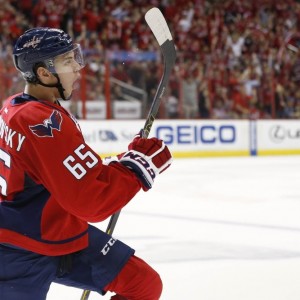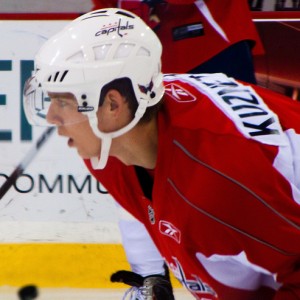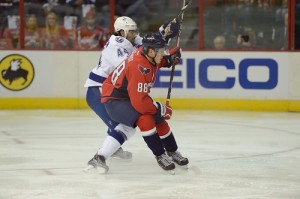
After an up-and-down regular season last year, rookie forward Andre Burakovsky got his game going just as the Wasington Captials were eliminated from the second round of the playoffs by the New York Rangers. Then he hustled off to Hershey in time to play one game and experience the Bears’ elimination from the AHL postseason. Bam. Just like that. Stopped in his tracks.
Fast-forward to January 2016. The young and the talented Austrian-born Swede gets bumped up to the second line after an injury to Capitals third-line center Jay Beagle forces second-line winger Marcus Johansson to drop down and center the third line. Given a chance to play alongside players possessing a similar skill set such as Evegeny Kuznetsov and Justin Williams, Burakovsky again begins to flourish, notching three goals, six assists and a plus-five rating over a six-game span – capped by a two-goal effort in a 4-3 overtime loss to the Philadelphia Flyers Wednesday.
Then, just like that, it’s break time. As in the All-Star break. Once again Burakovksy is stopped in his tracks just as he hit his stride. But this time around he isn’t heading into a several-month break away from the NHL game and facing the daunting task of having to prove himself all over again in training camp.
Last summer Capitals head coach Barry Trotz stated publicly several times that he expected Burakovsky to open the season on the team’s second line following his solid late-season performance. Those comments, however, may have served the dual purpose of trying to build his young, skilled forward’s confidence while also trying to motivate RFA Johnasson to come to camp prepared to fight for his second-line spot.
As it turned out, Johansson had a great training camp and start to the regular season, while Burakovsky seemed to be pressing a bit in an attempt to do too much. Johansson ended up on the second line, and Trotz decided to use Burakovsky in a lesser role on the third and fourth lines. He was afforded that luxury thanks to the Caps’ best start in franchise history and tremendous forward depth.
It wasn’t a complete demotion, however. Every now and then, when the team was struggling offensively, Trotz would sneak Burakovsky onto the ice with a more-skilled group, and he even gave the young playmaker some minutes on the second power play unit. Suddenly, when injuries and suspensions struck, Trotz had a tested player who had been improving steadily ready to pick up the slack and help the team continue its stellar play.
“Early in the year pucks were bouncing off his stick, Trotz said of Burakovsky. “He wasn’t strong, and it wasn’t happening for him – a little jammed up I like to say. Right now I have a lot of {confidence in} his game. When a player of his ability wants the puck it’s a good thing because they’re going to be pretty productive, and he has been. That line has been.”
While Burakovsky’s individual numbers over the last six games have been impressive, his play also has helped spark the entire line. During the same span Justin Williams has 4-3-7, including a hat trick against the Rangers Jan. 17, and is a plus-6, while Kuznetsov has 2-10-12 and is a plus-5. It’s no coincidence that the team is 5-0-1 in those contests.
This time after a much shorter break, given his recent offensive surge and the strong play of Johansson as the third-line pivot, Burakovsky will return knowing that the spot on the second line is his to lose – at least until Beagle returns in late February. And based on Trotz’ recent history handling young players, Caps fans have a lot to look forward to from Burakovsky during the final 30-plus games of the year. Burakovsky, who saw between nine and 12 minutes of ice time per game throughout the month of December, has been on the ice between 14 and 16 minutes a game most times out in January.
Patience a Virtue with Capitals’ Youngsters

Last season Trotz handled Burakovsky’s young teammates Kuznetsov and defenseman Nate Schmidt in a similar, patient manner, and the results have been spectacular.
Kuznetsov spent a great deal of time last year on the fourth line or bouncing around as a fill-in on other lines. By the end of the season he was a consistent 15-to-20-minute-a-game option, recording 5-8-14 and a plus-5 over the final 17 games of Washington’s playoff run. Then in the postseason he had 5-2-7 and a plus-4, including the opening-round Game 7 series-winning goal against the Islanders, while seeing between 15 and 21 minutes per outing.
This year the young Russian has been one of the league’s biggest surprises and the Caps’ most consistent offensive player, with 15-34-49 while logging between 18 and 20 minutes of ice a night. He leads the team and ranks fifth in the league in points and fourth in assists while possessing the NHL’s top plus-minus number at plus-24. He also has three game-winning goals, including two overtime beauties.
The swift-skating Schmidt played half the season in Washington under Trotz a year ago alongside veteran Mike Green before being sent to Hershey to work on the areas of his game the coaching staff saw as deficient. An injury kept him out of the lineup for a long stretch before he got a late-season call-up to D.C. to see how he had progressed. For the year at the NHL level Schmidt appeared in 39 contests posting 1-3-4 and a minus-2.

The team had seen enough from him to know that he was going to be one of their top six this year, meaning they could afford to let free agents Green and Tim Gleason move on. Schmidt began the year as the number-six blueliner before being moved up in the lineup because of injuries to top-pairing d-men John Carlson and Brooks Orpik. Trotz’ patience again has been rewarded as Schmidt has notched 2-10-12 and an impressive plus-15 while skating as many as 23 minutes on several occasions.
“What you want to see with the young players, most importantly, is the consistency,” Trotz said when discussing Schmidt recently. “You want to have a player who can step up, and then they do it for a game or two, but he’s done it for a fair amount of time. That’s the most encouraging thing. He’s been pretty consistent. He doesn’t wow you one game and then the next game you go, ‘What happened?’ To me you’re crossing the threshold of being a good pro when you play with that consistency, and that’s the way it’s been with Nate.”
The Future is Bright
So now it appears as though the sky is the limit for Burakovsky, a fast skater with good hands and an accurate, quick-release shot. He was inserted in the lineup during the postseason last year after an injury sidelined Eric Fehr and performed well enough for the team to know he was going to be among their future top six. But there still was work to be done, and with enough forward depth to win and still bring the youngster along slowly, Trotz put Burakovsky on the Kuznetsov/Schmidt plan.
“When a player is young you want to show him the right way to do things, the right ropes, the right direction to go in, keep them accountable,” Trotz said. “Hopefully with the guys you have in your room and the culture, it aids that process and then hopefully a young player gets to the point where he wants to be better and better and better and keeps working at his craft. Once you get that, you give the player ownership, and once a player takes pure ownership of his game, from the training to getting better to all those aspects – accountability and self-accountability – then you’ve got a really good pro.
“Coaching becomes really easy when you’ve got guys who really know the game and want to get better at the game in every aspect and are looking for that next thing that’s around the corner. When you have that hunger for knowledge and getting better, then you’re going to pull everyone with you. We’ve got a few guys like that, which is tremendous. “